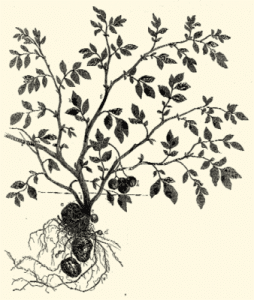The Potato Blight – It’s Origin
 The fungus that decimated the potato fields of Ireland in the mid-nineteenth century is well named. Phytopthora infestans, literally “infesting plant destroyer,” can, under the right conditions, reduce the foliage of a field of potatoes into a putrid mass in just a few days. A common disease of potatoes wherever they are grown,the devastating fungus is particularly prevalent in areas where the weather is unusually cool and wet, such as it is in Ireland. Remaining localized during the years where weather conditions were warm and dry,the disease became widespread in the wet years of the mid-1840s.
The fungus that decimated the potato fields of Ireland in the mid-nineteenth century is well named. Phytopthora infestans, literally “infesting plant destroyer,” can, under the right conditions, reduce the foliage of a field of potatoes into a putrid mass in just a few days. A common disease of potatoes wherever they are grown,the devastating fungus is particularly prevalent in areas where the weather is unusually cool and wet, such as it is in Ireland. Remaining localized during the years where weather conditions were warm and dry,the disease became widespread in the wet years of the mid-1840s.
Crossing from North America to Belgium in 1845,the potato blight traveled to the Isle of Wight and then to England. Following its devastation of the potato crops in both France and Holland,the fungus appeared in Ireland in September 1845 where it promptly destroyed about forty percent of the country’s potato crop. In 1846, almost one hundred percent of the crop was lost. The year 1847 was considered the worst of all because of the especially harsh winter; crops fared no better from 1848-49. These losses were catastrophic to the people who lived in rural Ireland because of their forced and complete dependence on the potato.
The disease remained a mystery to botanists,who mistakenly attributed its cause to excess moisture created by the damp,still weather. In 1845, the official committee of inquiry, believing the disease to be a kind of “wet rot,” suggested that the best way to prevent the rotting of the potatoes was to store them in well-ventilated pits. Other suggestions offered to alleviate the dampness included drying the potatoes with air, drying them in a kiln, or covering them with ashes. Most experts in 1845 did not seriously consider the idea that the mold on the potatoes could have been caused by a fungus. This misdiagnosis led to government complacency about the potato harvest of 1846 and the failure to remedy the problem in the years immediately following. Back…






